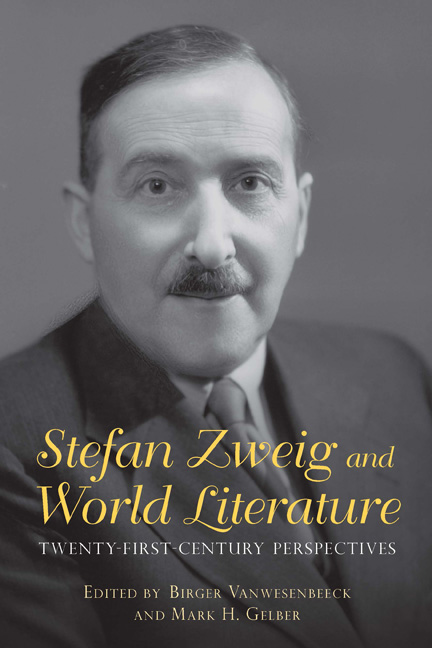Book contents
- Frontmatter
- Dedication
- Contents
- List of Illustrations
- Acknowledgments
- Introduction
- Part I Reception
- Part II Drama and Fiction
- Part III Criticism and Essays
- 5 Stefan Zweig and the Concept of World Literature
- 6 Landscape, “Heimat,” and Artistic Production: Stefan Zweig's Introduction to E. M. Lilien: Sein Werk
- 7 Stefan Zweig's Non-fictional Prose in Exile: Mastery of the European Genre of “Kunstprosa”
- Part IV Politics and Exile
- Notes on the Contributors
- Index
6 - Landscape, “Heimat,” and Artistic Production: Stefan Zweig's Introduction to E. M. Lilien: Sein Werk
from Part III - Criticism and Essays
Published online by Cambridge University Press: 05 May 2015
- Frontmatter
- Dedication
- Contents
- List of Illustrations
- Acknowledgments
- Introduction
- Part I Reception
- Part II Drama and Fiction
- Part III Criticism and Essays
- 5 Stefan Zweig and the Concept of World Literature
- 6 Landscape, “Heimat,” and Artistic Production: Stefan Zweig's Introduction to E. M. Lilien: Sein Werk
- 7 Stefan Zweig's Non-fictional Prose in Exile: Mastery of the European Genre of “Kunstprosa”
- Part IV Politics and Exile
- Notes on the Contributors
- Index
Summary
Ephraim moses lilien was not yet thirty years old when a monograph appeared chronicling his work and celebrating him as one of the greatest artists to emerge during a period of cultural renaissance among European Jews. This 1903 monograph, titled E. M. Lilien: Sein Werk, mit einer Einleitung von Stefan Zweig (E. M. Lilien: His Work, with an Introduction by Stefan Zweig, 1903) included an introductory essay by an even younger Stefan Zweig along with reproductions of bookplates, drawings, and book and magazine illustrations spanning Lilien's career up to that point. In his introductory essay, Zweig detailed major stations in Lilien's artistic development and discussed Lilien's artwork as central to the emergence of Jewish national consciousness.
Lilien's work is scarcely known outside specialist circles today, but there can be little doubt of his historical prominence as a major figure in European-Jewish art. Significantly, the beginning of Lilien's artistic output coincided with the so-called “Jewish Renaissance,” which began at the fin-de-siècle and marked a renewed engagement with Jewish history and culture. Although the exponents of the Jewish Renaissance, including most prominently Martin Buber, shared many beliefs with members of the Zionist movement, the Jewish Renaissance remained a cultural movement focused on the creation of modern, self-consciously Jewish art and thought, rather than on the foundation of a Jewish nation-state. The monograph thus served as an ideal vehicle for taking stock of recent developments in Jewish art and, ultimately, for exploring some of the most prominent debates within Zionism around 1900. It is Zweig's rich introduction to this text, however, which deserves special attention from scholars today, particularly because of the way Zweig characterizes Lilien's talent and importance. The introductory essay unfolds around a biographical sketch of the artist outlining three major stages in his creative development: his youth in the Galician city of Drohobycz, where he was apprenticed to a sign painter; his failed attempt at artistic success in Vienna, and his ultimate breakthrough in Munich with the journal Jugend; and his collaborations with two radically different poets: the völkisch-nationalist German aristocrat Börries von Münchhausen, and the Galician-born poet of the sweatshops of New York and London, Morris Rosenfeld.
- Type
- Chapter
- Information
- Stefan Zweig and World LiteratureTwenty-First Century Perspectives, pp. 108 - 121Publisher: Boydell & BrewerPrint publication year: 2014



